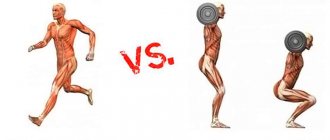- Where does the energy come from?
- What is aerobic exercise?
- The benefits of aerobic exercise
- Types of aerobic training
- What is anaerobic exercise?
- The benefits of anaerobic training
- Types of anaerobic training
Physical activity is divided into aerobic and anaerobic depending on which system predominates in energy supply. Energy in the body is formed with the participation of oxygen (aerobic exercise) and without oxygen (anaerobic exercise) - to put it simply. Strictly speaking, there is no completely aerobic or anaerobic metabolism; they are always mixed.
It is important to distinguish between aerobic and anaerobic exercise in order to train effectively and without compromising your health. Especially if you train on your own. And when training with a trainer, a general understanding of the loads will improve mutual understanding in the preparation process.
Source: Photo by 白晓东 on Unsplash
Where does the energy come from?
The body's source of energy is a high-energy chemical called adenosine triphosphate, or ATP. When muscles work, ATP breaks down into adenosine phosphate or ADP, releasing energy. ATP reserves in the muscles are enough for only a few seconds of work. To replenish ATP reserves, muscles have energy systems: aerobic (oxygen) and anaerobic (lactate and phosphate). They restore ATP from its breakdown product ADP, and the body continues to function. Depending on what mechanism of energy production operates during physical activity, training is divided into aerobic and anaerobic.
During aerobic exercise, there is enough oxygen for metabolism. When anaerobic - there is not enough, acidification occurs. Aerobic exercise can also be of varying intensity; the bulk of training takes place in this range. Aerobic exercise creates the basis for the development of anaerobic exercise. It is important to know the moment where aerobic exercise turns into anaerobic exercise - the lactate threshold point or LTP.
Aerobic exercise develops overall endurance and is therefore important for long-distance runners. Anaerobic exercise is important for sprinters. However, in any sport, focusing on one type of training is ineffective and can lead to overtraining, so it is necessary to alternate the load.
Source: Axel Brunst on Unsplash
Cardio load
Cardio exercise is a type of physical activity that affects the heart rate and increases the contractions of the heart muscle . The main benefit of these trainings is that the heart is strengthened and its function is stabilized.
A healthy and strong heart improves a person’s well-being. If there are any problems with this organ, a general deterioration in the body’s condition immediately occurs. Improvement of the body occurs when the heart rate increases, which can be achieved through cardio exercise. However, it is highly not recommended to load the heart muscle too intensely.
The main guideline when performing such training is the individual condition of the person, which also requires the selection of various individual programs. Otherwise, the body may receive a very high load, which will lead to dire consequences in the future.
When choosing an individual load level, it is necessary to take into account fitness, pressure and pulse when performing exercises, since the heart muscle can contract both slightly and extremely.
A gradual increase in load can be tolerated by a person who regularly plays sports without any problems. Those in poor health and older people should give preference to light exercise.
Various cardio exercises are combined with aerobic ones:
| Type of occupation | Features of the event |
| Run | It is considered a popular type of cardio exercise. At the stage of this exercise, most of the muscles are loaded, so there are a number of contraindications. For example, you should refuse to perform the exercise and consult a doctor in case of sore joints or spine, as well as in the presence of heart pathologies. The specialist will give some recommendations that will allow you to conduct such classes. |
| Cycling | They influence the strengthening of the heart, various muscle groups, and also affect weight loss in general. An analogue can be an exercise bike. |
| Dancing | The effect is similar to that of working out in the gym. Dancing increases your heart rate, which has a positive effect on the volume of your muscles and heart. In addition, the body acquires plasticity, elegance and grace. |
| Walking | The training is suitable for beginners, since it is advisable to start playing sports with intense walking. The pace should be increased gradually, because high loads are very dangerous to health. |
Cardio exercise can improve your health and also make your body slim. To obtain the required result, classes must be carried out at least 4 - 5 times every 7 days.
Anaerobic and aerobic exercise is widely in demand by people who lead an active lifestyle. The first type is training that is aimed at building muscles, the second type is focused more on strengthening the cardiovascular system. To obtain the maximum and effective effect, you need to combine 2 types of training, as well as take into account personal capabilities.
The benefits of aerobic exercise
Aerobic training is the basis of any athlete and the foundation of all cyclic sports. These are long-term, low- and medium-intensity workouts that prepare the body for high-intensity loads. Aerobic training strengthens the heart and blood vessels, increases overall endurance and prepares the body for high stress.
During aerobic exercise, energy is released as a result of the interaction of oxygen with carbohydrates and fats. On average, carbohydrate reserves last for 1.5-2 hours of running, and fat reserves last for more than 100 hours. But in order to run “on fat,” the body must be trained.
Source: trainright.com
Advanced level
Endurance is an important aerobic characteristic that has certain limits. The advanced level implies that the athlete has achieved the desired physical condition and condition, and his goal, by and large, is to maintain performance and, if possible, improve it.
Burpee exercise diagram for aerobic endurance training
For an advanced level, all the above exercises are suitable, which can be made more complex, including by increasing the pace and duration of the workout.
A trained person, unlike a beginner, is able to perform more complex exercises:
- Burpee. Place your feet shoulder-width apart and squat as low as possible. Place your palms on the floor and jump into plank pose with your arms outstretched. Jump forward, pulling your legs towards your chest. Shift your body weight to your feet, jump up with a jerk, raising your arms.
- Climber . Stand in a horizontal plank position with your arms outstretched. Alternately pull your legs towards your shoulders while jumping, gradually increasing the pace.
- Jumping with lunges. Stand straight, feet shoulder-width apart, hands on your waist. Step forward into a lunge, with your knee forming a right angle. Change legs while jumping.
Types of aerobic training
Aerobic training is a long-term, low-intensity endurance exercise. The pulse lies within 60-85% of the maximum heart rate, but the main range is 70-80%. Aerobic training varies in intensity level:
- Intense . These are interval workouts consisting of a series of short accelerations with intermediate recovery. During acceleration, the heart rate can reach 85-90% of the maximum heart rate. This is a transition zone between aerobic and anaerobic training, so there may be a slight increase in lactate levels.
- Intermediate . These are long runs of moderate intensity or cycling, the heart rate is within 80-85% of the maximum heart rate.
- Extensive . These are long continuous workouts at a heart rate of 70-80% of the maximum heart rate: running at a calm pace, swimming. During such training, energy is obtained through the oxidation of fats, which allows you to save carbohydrates and maintain performance longer. This type also includes recovery training, where the heart rate should be below 70% of the maximum heart rate.
Read: Pulse when running: pulse zones, how to lower heart rate, video
Differences between aerobes and anaerobes
The distinctive features of microorganisms are presented in the table.
| Comparison parameter | Aerobes | Anaerobes |
| Conditions of survival | Require oxygen as it is the final electron acceptor in their cellular respiration | They do not need oxygen for cellular respiration |
| Ultimate electron acceptors | Oxygen | Sulfur, methane, nitrogen, iron |
| Processes involved in cellular respiration | Glycolysis, Krebs cycle, Electron transport chain | Glycolysis, Fermentation |
| Varieties | Obligate, Microaerophilic, Facultative, Aerotolerant | Obligate, Facultative |
| Environment for growth | Oxygen-rich environments | Environments lacking oxygen |
| Oxygen toxicity | Non-toxic | Toxic |
| Oxygen detoxifying enzymes | Present | None |
| Energy production level | High energy production efficiency | Low energy production efficiency |
| Examples | Bacillus subtilis (Bacillus spp), Pseudomonas aeruginosa, Koch bacillus (Mycobacterium tuberculosis) | Actinomyces, Bacteroides, Propionibacterium, Veillonella, Peptostreptococcus, Porphyromonas, Clostridium spp |
Aerobes and anaerobes require different levels of oxygen in nutrient media for survival. Aerobic microorganisms need oxygen for energy metabolism, but anaerobic microorganisms do not use it. Instead, they use nitrates, sulfur and methane. That is why the key differences between these microorganisms are the types of final electron acceptors that are used in the process of cellular respiration.
Share link:
What is anaerobic exercise?
Anaerobic exercise - in which energy is produced almost without the participation of oxygen. These may be lactate or phosphate mechanisms for ATP resynthesis. They differ from the aerobic method in the rapid rate of energy production, but their reserve is only enough for a few minutes of intense work.
Anaerobic mechanisms supply energy to intense muscle work and are also activated briefly at the very beginning of any physical exercise. This is explained by the slow “switching on” and adaptation of the oxygen system.
Lactate energy system
The lactate system produces energy through the breakdown of carbohydrates without the participation of oxygen. Glycogen reserves are enough for 60-90 minutes of intense work.
Along with energy, lactic acid is released as a by-product. With a lack of oxygen, lactic acid cannot be processed and accumulates in the muscles. Muscle acidification is called acidosis. This condition is familiar to many athletes: a feeling of heaviness, muscle pain and lack of coordination.
It may take 30-90 minutes to 24 hours for cells to recover from acidosis and remove lactic acid. This depends on the amount of accumulated lactate and the intensity of the exercise. To ensure your body has time to recover, do high-intensity training no more than 2 times a week and don’t forget about active recovery.
Phosphate power system
The phosphate system produces energy through the high-energy substance creatine phosphate (CrP), without the participation of oxygen. The phosphate mechanism resynthesizes ATP faster than other systems, but the CrP reserves in the muscles are only enough for 6-8 seconds of intense work. KrF is also restored quickly - within 3-5 minutes immediately after completing the load.
Source: apnews.com
Types of anaerobic training
Anaerobic training is short-term, high-intensity exercise. The pulse lies within 85-100% of the maximum heart rate. Anaerobic training includes: strength exercises, shuttle running, long jumps, long accelerations, intervals, training in the mountains.
Do you like our project? Support us on Patreon or choose another way to support the project. Even a small help is a big contribution to our business.
Subscribe to us on Instagram, Telegram, YandexZen and Vkontakte.
A little about muscle hypertrophy
An increase in the volume and density of muscles, their saturation with blood capillaries and nerve endings is due to the growth of muscle cells. This process is an adaptation of muscles to loads and in skeletal muscles (forming muscle relief) it is most stimulated by anaerobic training.
Benefits of Hypertrophy:
- developed muscles,
- prevention of blood pressure problems,
- high metabolism,
- strong bones,
- quick recovery after training,
- stable weight.
Types of muscle hypertrophy
Myofibrillar – observed due to an increase in the volume and number of myofibrils, i.e. protein microfibers in the muscle cell.
Result: the strength of muscle contractions is ensured.
Sarcoplasmic - due to an increase in the volume of sarcoplasm (nutrient fluid around muscle fibers) and “energy” organelles (mitochondria).
Result: muscle endurance is ensured.
It is believed that anaerobic training has the most effective effect on hypertrophy. To achieve your goal, you need to perform strength exercises with a fair amount of weight and a low number of repetitions.










